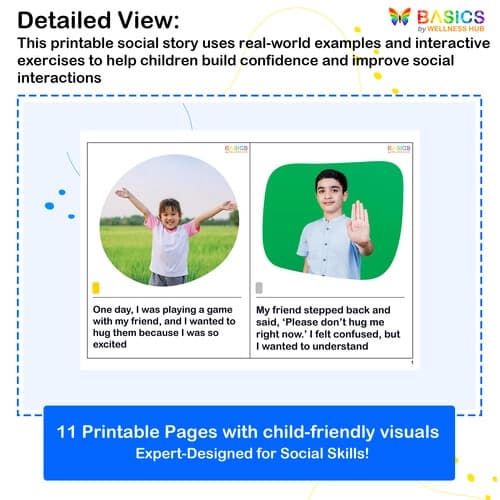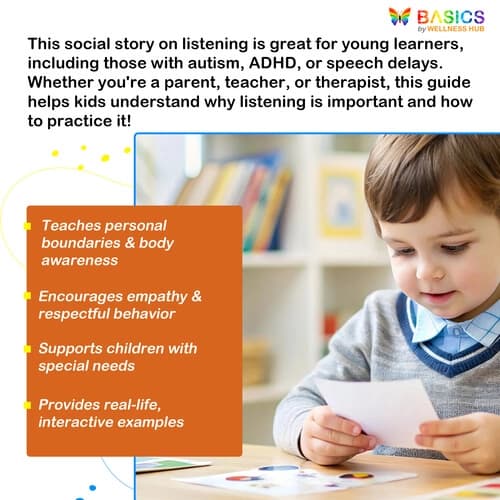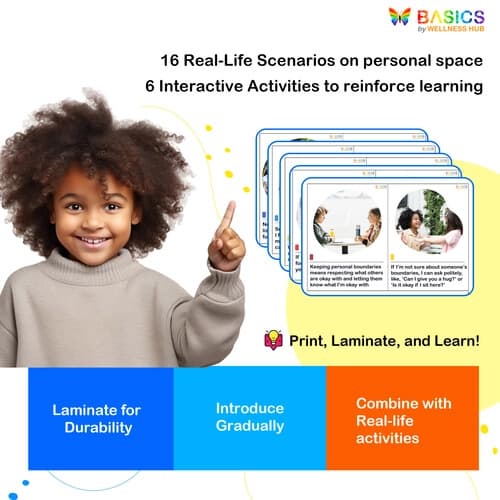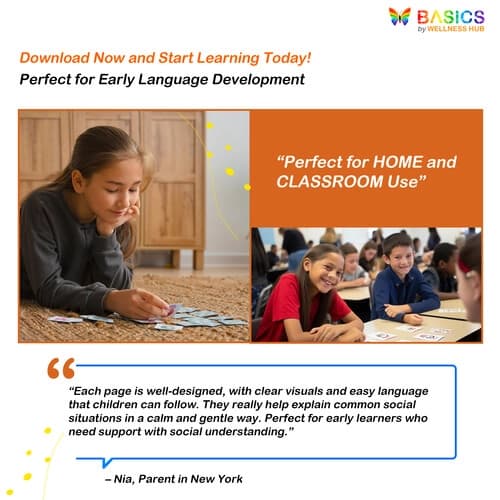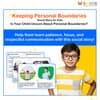


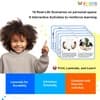
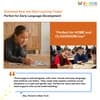
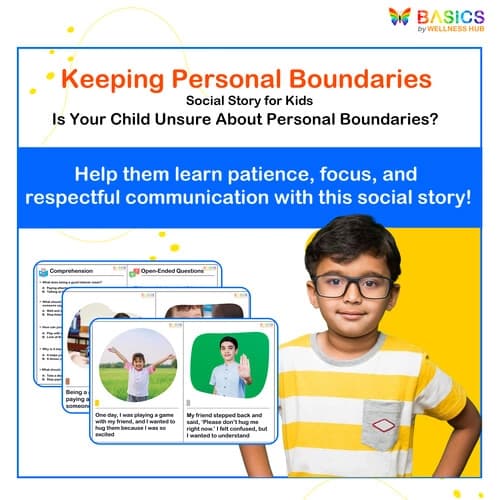
Keeping Personal Boundaries – Free Social Story for Kids’ Personal Space
FREE
₹160
100% off
0 (0 ratings)
Grade Levels
Pre-K - Grade 3 (Ages 4-9)
Content Overview
Format: Free Printable PDF, Total Pages: 11, Features (≤15 words): 16 real-life segments, interactive activities, child-friendly illustrations
Categories
Pages from the Resource
Teach children the importance of keeping personal boundaries with this free social story. Using 16 relatable scenarios, interactive activities, and engaging illustrations, kids learn appropriate personal space, empathy, and polite behavior. Ideal for children with autism, ADHD, or social-emotional challenges—great for home, school, or therapy.
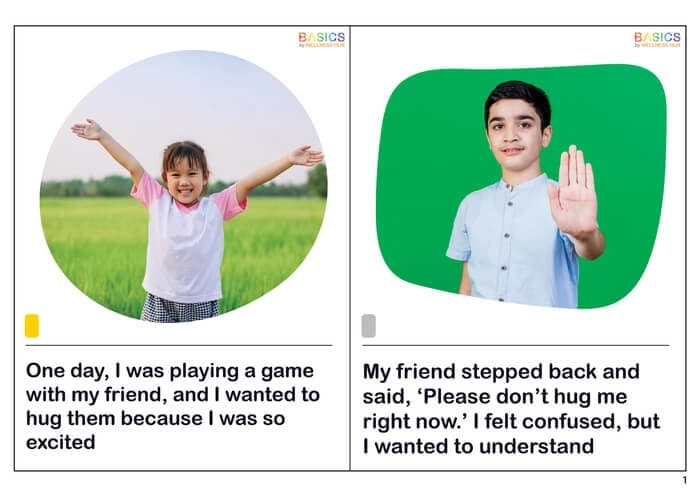
Page 1
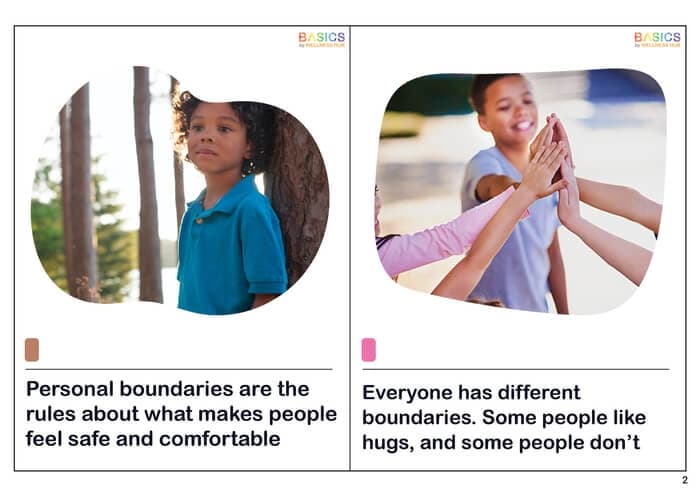
Page 2
What Users Say
0
0 ratings
5
0+
4
0+
3
0+
2
0+
1
0+
5 Stars
Product is Good to use.
1 year ago
Varsha Parent
Similar Products
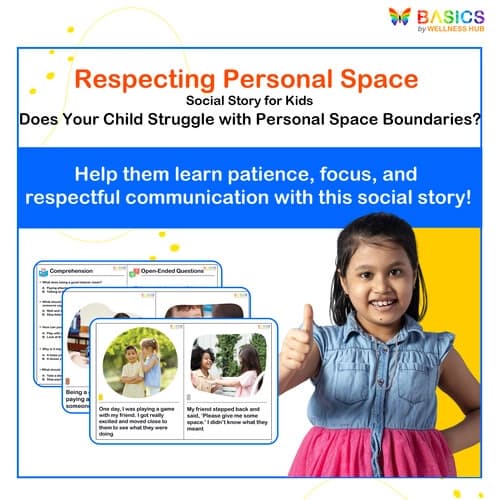
Respecting Personal Space – Social Story for Kids’ Personal Boundaries
₹ 80.00
₹ 160.00
50% off
4.9 (54 ratings)
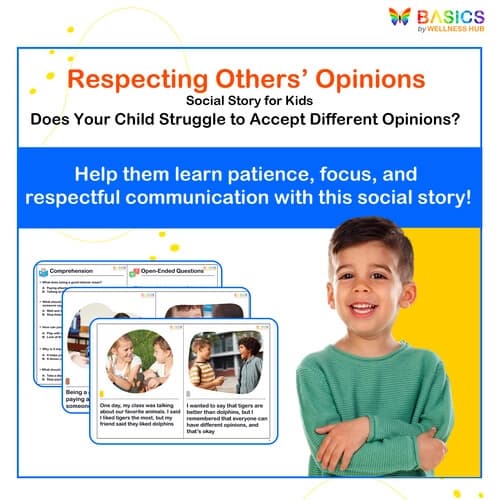
Respecting Others’ Opinions – Free Social Story for Kids
₹ 80.00
₹ 160.00
50% off
4.8 (46 ratings)
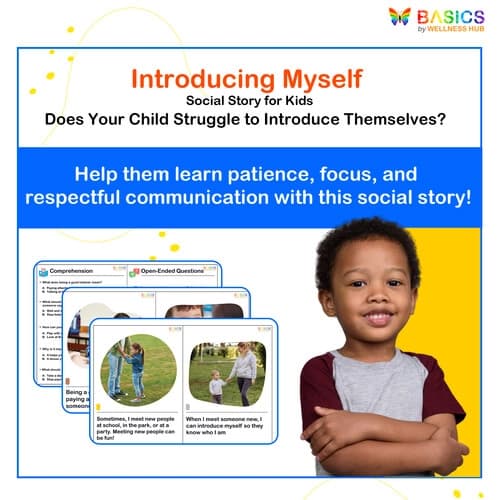
Introducing Myself – Free Social Story for Kids’ Communication Skills
₹ 80.00
₹ 160.00
50% off
4.8 (60 ratings)

What to Do When I Want to Shout – Free Social Story for Self-Regulation
FREE
₹160
100% off
4.7 (58 ratings)
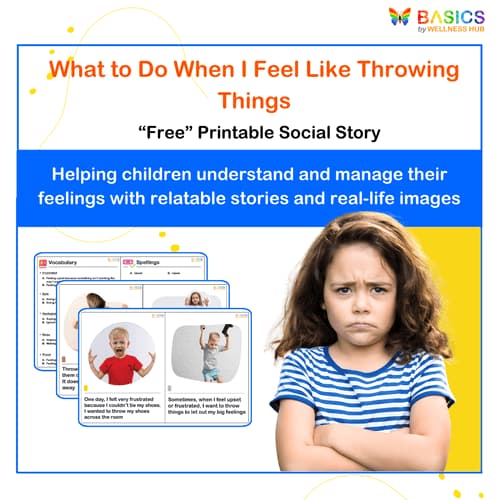
What to Do When I Feel Like Throwing Things – Free Printable Social Story
FREE
₹160
100% off
4.8 (46 ratings)
About the Product
Introduction
Understanding and maintaining personal boundaries is an essential social skill for children. By learning how to respect their own space and recognize others’ comfort zones, children can foster healthier friendships, improve communication, and reduce conflicts.
However, many young children—especially those with autism, ADHD, or other social-emotional challenges—struggle with the concept of personal space. They might stand too close, touch others without asking, or feel uneasy when others invade their space. This free social story provides a structured, kid-friendly approach to help them grasp physical boundaries, body language cues, and appropriate ways to interact in group settings.
Whether used in classrooms, therapy sessions, or at home, this resource gives children the practical knowledge and confidence to engage respectfully with peers and adults.
Product Details
- Format: Free Printable PDF
- Total Pages: 11
- Segments: 16 real-life scenarios showing various personal space interactions
- Features:
- Interactive activities to reinforce lessons and encourage practice
- Engaging illustrations to make concepts clear and relatable
- Easy-to-follow language suited for children ages 4-9
- Child-friendly examples focusing on everyday situations (e.g., playground, classroom, home)
Who Can Benefit:
- Parents and caregivers looking for ways to teach personal space boundaries at home
- Teachers aiming to reduce classroom conflicts and promote respectful behavior
- Therapists and special educators supporting children with social skill challenges, including autism or ADHD
This comprehensive, easy-to-use social story helps children recognize and respect personal boundaries in a fun, engaging format.
Educational Benefits
- Teaches Personal Space Awareness
- Provides concrete examples of appropriate distance and physical contact.
- Encourages children to read body language cues (like stepping back or looking uncomfortable) to gauge others’ comfort levels.
- Develops Empathy & Respect
- Helps children understand how their actions affect others.
- Reinforces the importance of asking before hugging or touching
- Promotes Social Comfort & Safety
- Reduces anxiety or misunderstandings by establishing clear boundaries.
- Teaches kids to politely assert their own boundaries and respond calmly when others aren’t respecting them.
- Supports Special Education & SEL
- Uses visual storytelling and step-by-step scenarios ideal for kids with autism, ADHD, or learning differences.
- Enhances social-emotional learning (SEL) by combining empathy, respect, and emotional regulation.
With consistent practice and positive reinforcement, children develop healthier interactions, greater confidence, and improved social skills.
Instructions for Use
1. Read the Social Story Aloud
- Begin by reading the social story together with the child.
- Pause after each scenario to ask open-ended questions such as:
- “What would you do if someone stood too close to you?”
- “How can you tell if a friend needs more space?”
- Encourage the child to share personal experiences where they felt uncomfortable or noticed someone else’s discomfort.
2. Engage with the Interactive Activities
- Each scenario or activity reinforces the concept of personal space and respectful boundaries.
- Role-play different situations (e.g., classroom line, sharing a couch, or greeting someone) to practice the lessons learned.
- Use visual aids such as tape on the floor or hula hoops to demonstrate appropriate distance.
3. Apply Lessons in Real Situations
- Encourage the child to apply what they’ve learned during daily routines, like waiting in line or playing games with others.
- Offer gentle reminders if the child forgets and positive feedback when they succeed.
- Use simple phrases from the story (e.g., “Arm’s length distance,” “Ask first before hugging,” etc.) to consistently reinforce
4. Track Progress and Offer Praise
- Consider creating a "Personal Space Chart" or sticker reward system to track successful interactions.
- Praise the child’s efforts and improvement in respecting personal boundaries. Acknowledging their achievements helps build confidence and motivation.
Additional Tips:
- Review the social story weekly or as needed to reinforce important concepts.
- Adapt the scenarios for the child’s specific environment (home, playground, therapy, classroom).
- Communicate with other caregivers, teachers, and family members so they can support the child’s consistent learning of personal space boundaries.
Activities Using the Resource
These hands-on activities reinforce the lessons from the “Keeping Personal Boundaries” social story. They help children apply what they’ve learned about respecting personal space, body language cues, and proper distance in day-to-day interactions.
1. Bubble Space Role-Play
Objective: Teach children how to recognize and maintain an appropriate personal space “bubble.”
- Materials:
- Optional: Hula hoops or chalk/tape on the floor to mark space.
- How to Play:
- Explain the concept of each person having an invisible “bubble” around them.
- Have children stand in a spot with enough distance to avoid touching others’ invisible bubbles.
- Role-play scenarios like greeting a friend or standing in line. Encourage them to adjust if they invade someone’s space or if someone invades theirs.
- Praise the child when they correctly keep a comfortable distance and use polite language to ask for more space if needed.
2. Personal Space Scenarios Sorting
Objective: Help children differentiate respectful vs. disrespectful personal space behaviors.
- Materials:
- Printable scenario cards (examples included in the resource).
- How to Play:
- Lay out cards describing different personal space interactions (e.g., “Bumping into a friend without apologizing,” “Standing quietly arm’s length away,” etc.).
- Have the child sort these cards into two piles: “Respectful Boundaries” and “Not Respectful”.
- Discuss why each behavior is respectful or not. Reinforce the positive examples by asking the child to role-play
3. Ask First Exercise
Objective: Reinforce the idea that children should ask for permission before entering someone’s personal space.
- Materials: None required (just everyday interactions).
- How to Play:
- Encourage the child to say “Can I give you a hug?” or “May I sit close to you?” before hugging or sitting beside someone.
- Role-play with a family member, teacher, or peer to practice saying these phrases.
- Celebrate or reward the child when they respect the answer (e.g., if someone says “No” or “I need some space,” the child learns to step back politely).
4. Personal Space Reflection Chart
Objective: Track daily or weekly improvement in respecting personal boundaries.
- Materials:
- A simple chart or calendar to record successes.
- How to Play:
- Decide on specific goals like “Give friends enough space in line” or “Ask before hugging.”
- Every time the child achieves a goal (e.g., maintains personal space on the playground), add a sticker or mark the chart.
- Offer small rewards or extra praise after a certain number of achievements (e.g., 5 successful boundary interactions).
5. Arm’s Length Game
Objective: Visually demonstrate the comfortable distance children should keep when interacting with others.
- Materials: None required (optionally, colored tape on the floor).
- How to Play:
- Have children stand at arm’s length from each other to form a circle.
- Move around the circle, instructing them to check if they remain arm’s length without bumping into each other.
- Emphasize that arm’s length can be a good rule of thumb when talking to someone or waiting in line.
FAQs
Q1: Who is this social story designed for?
A1: This resource is ideal for children aged 4–9 who need help understanding personal space and social boundaries. It’s especially beneficial for those with autism, ADHD, or other social-emotional challenges. Parents, teachers, and therapists can use it to reinforce respectful behavior at home, in classrooms, or during therapy sessions.
Q2: How can I incorporate this social story into daily routines?
A2:
✔ Read the story with your child regularly, emphasizing certain scenarios that mirror real-life events.
✔ Discuss personal space incidents (e.g., during a playdate) using language from the story.
✔ Refer to specific segments in the story when a child forgets to maintain distance or needs a reminder.
Q3: Can older or younger kids also benefit from this story?
A3: Yes! While it’s designed for ages 4–9, the simple language and clear illustrations can be adjusted or expanded. Younger kids may need fewer details, and older kids can use extended role-play or more complex scenario discussions.
Q4: Is it suitable for children with special needs?
A4: Absolutely. The step-by-step format and visual examples are particularly helpful for kids with autism or other developmental differences. The interactive activities also make it easier for children to internalize the concept of personal space.
Q5: Do I need special materials for the activities?
A5: No. Most activities only require basic household items (like tape or a chart) or can be done using everyday settings and role-play. The activities included are designed to be flexible and easy to set up.
Q6: How do I motivate a child who resists these lessons?
A6:
✔ Stay positive and patient; use praise and small rewards for any attempt to respect boundaries.
✔ Model the behavior yourself—show how you maintain personal space in daily interactions.
✔ Make it fun by incorporating games and stickers. If the child resists, focus on short, repeated practice sessions rather than long lessons.
Usage Rights and Restrictions
This free printable social story is for personal, classroom, or therapy use. You may print and reproduce it for use with children in home or educational settings.
Not Allowed:
- Reselling, redistributing, or uploading the resource online for free or commercial use.
- Modifying the content for commercial purposes without permission.
- Sharing the PDF publicly on other websites without explicit consent.
For bulk licensing or commercial inquiries, please contact us directly.
Conclusion
The “Keeping Personal Boundaries – Free Social Story for Kids” empowers children to understand personal space, respect boundaries, and communicate their own comfort zones effectively. Through relatable scenarios, child-friendly language, and interactive activities, children learn how to navigate social interactions with confidence and empathy.
By practicing the strategies and concepts in this resource, children will be better equipped to avoid conflicts, enhance friendships, and foster a happier, more respectful environment—whether at home, school, or in therapy sessions.
